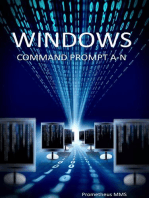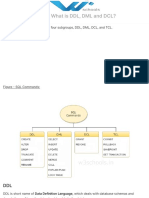What Are The Difference Between DDL, DML and DCL Commands - Oracle FAQ
Uploaded by
Rohan JainWhat Are The Difference Between DDL, DML and DCL Commands - Oracle FAQ
Uploaded by
Rohan JainWhat are the difference between DDL, DML and DCL
commands?
Submitted by admin on Wed, 2004-08-04 13:49
DDL
Data Definition Language (DDL) statements are used to
define the database structure or schema. Some examples:
CREATE - to create objects in the database
ALTER - alters the structure of the database
DROP - delete objects from the database
TRUNCATE - remove all records from a table, including
all spaces allocated for the records are removed
COMMENT - add comments to the data dictionary
RENAME - rename an object
DML
Data Manipulation Language (DML) statements are used for managing data within schema objects. Some
examples:
SELECT - retrieve data from the a database
INSERT - insert data into a table
UPDATE - updates existing data within a table
DELETE - deletes all records from a table, the space for the records remain
MERGE - UPSERT operation (insert or update)
CALL - call a PL/SQL or Java subprogram
EXPLAIN PLAN - explain access path to data
LOCK TABLE - control concurrency
DCL
Data Control Language (DCL) statements. Some examples:
GRANT - gives user's access privileges to database
REVOKE - withdraw access privileges given with the GRANT command
TCL
Transaction Control (TCL) statements are used to manage the changes made by DML statements. It allows
statements to be grouped together into logical transactions.
COMMIT - save work done
SAVEPOINT - identify a point in a transaction to which you can later roll back
ROLLBACK - restore database to original since the last COMMIT
SET TRANSACTION - Change transaction options like isolation level and what rollback segment to use
You might also like
- What Are The Difference Between DDL, DML and DCL Commands?No ratings yetWhat Are The Difference Between DDL, DML and DCL Commands?2 pages
- What Are The Difference Between DDL, DML and DCL Commands?No ratings yetWhat Are The Difference Between DDL, DML and DCL Commands?1 page
- What Are The Difference Between DDL, DML and DCL Commands - Oracle FAQNo ratings yetWhat Are The Difference Between DDL, DML and DCL Commands - Oracle FAQ2 pages
- What Are The Difference Between DDL, DML and DCL Commands?No ratings yetWhat Are The Difference Between DDL, DML and DCL Commands?1 page
- What Are The Difference Between DDL, DML and DCL Commands - Oracle FAQNo ratings yetWhat Are The Difference Between DDL, DML and DCL Commands - Oracle FAQ4 pages
- What Are The Difference Between DDL, DML and DCL Commands - Oracle FAQNo ratings yetWhat Are The Difference Between DDL, DML and DCL Commands - Oracle FAQ4 pages
- DDL, DML and DCL Statements: Presented By:-KajalNo ratings yetDDL, DML and DCL Statements: Presented By:-Kajal8 pages
- Worksheet - 1.3 Dbms Sarthak Verma Lab (20bcs3950)No ratings yetWorksheet - 1.3 Dbms Sarthak Verma Lab (20bcs3950)8 pages
- SQL Commands - DML, DDL, DCL, TCL, DQL With Query ExampleNo ratings yetSQL Commands - DML, DDL, DCL, TCL, DQL With Query Example9 pages
- SQL (Structured Query Language) : DatabaseNo ratings yetSQL (Structured Query Language) : Database6 pages
- SQL Commands - DML, DDL, DCL, TCL, DQL With Query Example100% (2)SQL Commands - DML, DDL, DCL, TCL, DQL With Query Example11 pages
- SQL Statements Categories: DDL - Data Definition Language.: Create Alter DropNo ratings yetSQL Statements Categories: DDL - Data Definition Language.: Create Alter Drop2 pages
- SQL - DDL, DQL, DML, DCL and TCL Commands: - Transaction Control Language. So We Will See in Detail About TCL As WellNo ratings yetSQL - DDL, DQL, DML, DCL and TCL Commands: - Transaction Control Language. So We Will See in Detail About TCL As Well2 pages
- A Presentation On SQL Commands by Harshitaa KapoorNo ratings yetA Presentation On SQL Commands by Harshitaa Kapoor14 pages



























































